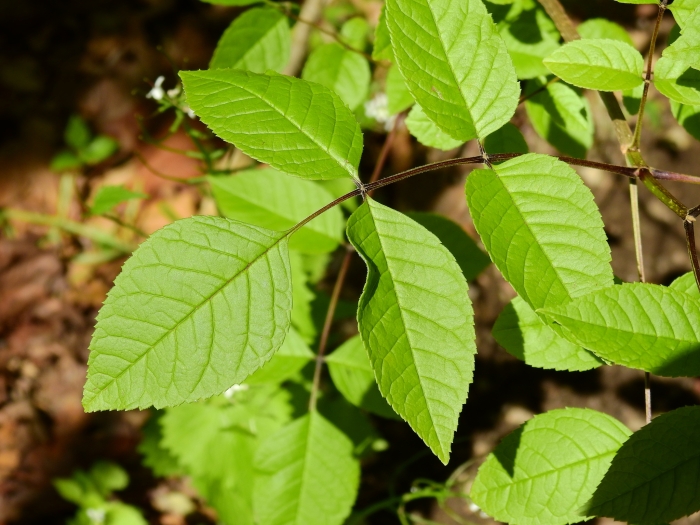Blue Ash
(Fraxinus quadrangulata)
Blue Ash (Fraxinus quadrangulata)
/
/

Yann Kemper
Public Domain
Image By:
Yann Kemper
Recorded By:
Copyright:
Public Domain
Copyright Notice:
Photo by: Yann Kemper | License Type: Public Domain | License URL: http://creativecommons.org/publicdomain/zero/1.0/ | Rights Holder: Yann Kemper | Publisher: iNaturalist | Date Created: 2021-04-25T14:17:35-07:00 |
















































Estimated Native Range
Summary
Fraxinus quadrangulata, commonly known as Blue Ash, is a medium-sized deciduous tree native to the central and eastern United States, particularly found in upland forests, limestone glades, and along stream banks. It typically reaches a height of 10–25 meters with a trunk diameter of 50–100 centimeters. The twigs of Blue Ash are notable for their four corky ridges, which give them a square appearance in cross-section, reflecting the species name, quadrangulata, meaning "four-angled." The winter buds are reddish-brown, and the small, purplish flowers emerge in early spring before the leaves, though they are not particularly showy. The tree is also recognized for its distinctive, winged seeds.
Blue Ash is valued for its drought tolerance and adaptability to different soil types, making it suitable for urban environments and reforestation projects. It is often used as a shade tree in parks and large gardens due to its open canopy and interesting bark texture. In cultivation, Blue Ash thrives in full sun and can handle a range of water conditions, from low to medium, and is adaptable to various soil drainage rates, from slow to fast. While not as common in cultivation as other ash species, it is resistant to the Emerald Ash Borer, a significant pest that has devastated many ash populations.CC BY-SA 4.0
Blue Ash is valued for its drought tolerance and adaptability to different soil types, making it suitable for urban environments and reforestation projects. It is often used as a shade tree in parks and large gardens due to its open canopy and interesting bark texture. In cultivation, Blue Ash thrives in full sun and can handle a range of water conditions, from low to medium, and is adaptable to various soil drainage rates, from slow to fast. While not as common in cultivation as other ash species, it is resistant to the Emerald Ash Borer, a significant pest that has devastated many ash populations.CC BY-SA 4.0
Plant Description
- Plant Type: Tree
- Height: 50-75 feet
- Width: 35-60 feet
- Growth Rate: Moderate
- Flower Color: N/A
- Flowering Season: Spring
- Leaf Retention: Deciduous
Growth Requirements
- Sun: Full Sun
- Water: Medium
- Drainage: Slow, Medium, Fast
Common Uses
Bee Garden, Bird Garden, Butterfly Garden, Deer Resistant, Drought Tolerant
Natural Habitat
Native to upland forests, limestone glades, and stream banks
Other Names
Common Names: Four-Angled Ash, Blau-Esche, Frêne Anguleux, Frêne Bleu, Frêne Quadrangulaire
Scientific Names: , Fraxinus quadrangulata, Fraxinus quadrangularis, Calycomelia quadrangulata, Fraxinus americana var. quadrangulata, Fraxinus quadrangulata var. subpubescens, Fraxinus tetragona, Leptalix quadrangulata,
GBIF Accepted Name: Fraxinus quadrangulata Michx.